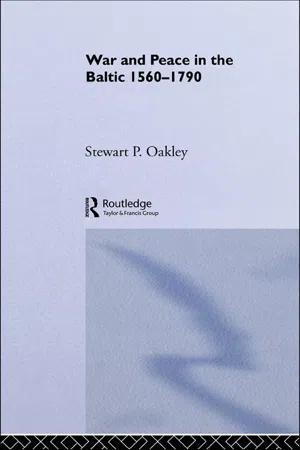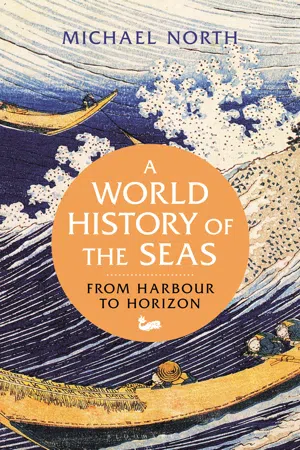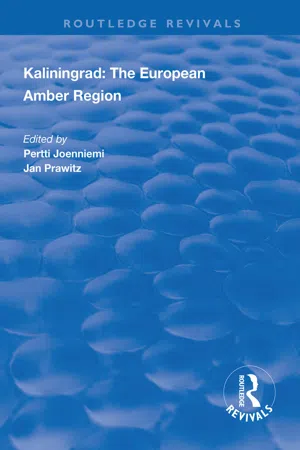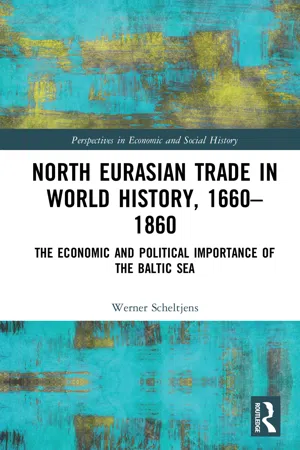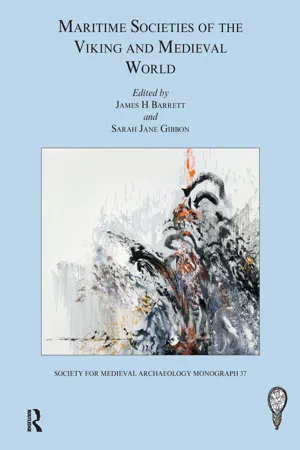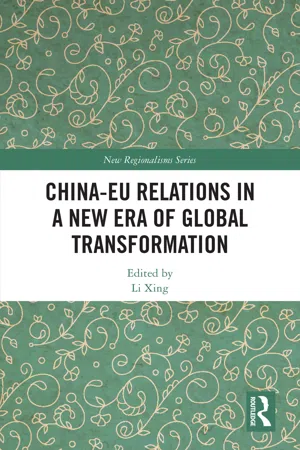Baltic Sea
The Baltic Sea is a brackish water body in Northern Europe, bordered by nine countries. It has been a significant trade route and has played a crucial role in the history of the region, particularly during the medieval and early modern periods. The sea has also been a site of military and political conflicts, shaping the history of the surrounding nations.
8 Key excerpts on "Baltic Sea"
- eBook - ePub
The Baltic
A History
- Michael North, Kenneth Kronenberg(Authors)
- 2015(Publication Date)
- Harvard University Press(Publisher)
...The enlargement of the EU since 2004, to which all states bordering the Baltic, with the exception of Russia, now belong, and the EU Baltic Sea strategy of 2009, have again changed our image of the region. The goal of the Baltic Sea strategy, with its focus on the environment, trade, security, and access, is to transform the Baltic region into a model of regional cooperation within the EU. The list of constructs of the Baltic Sea region that I have outlined—as missionary, trade, and EU model region—could be expanded more or less arbitrarily. 27 In fact, even the names for the Baltic and the present identification of the inhabitants of neighboring states with the Baltic reflect different perspectives. Whereas the Danes and Swedes call it the Eastern Sea (Ø sters ø en and Ö stersj ö n, respectively), and the Finns use It ä meri, which is a translation from Swedish and means the same thing, Estonians (logically) call the Baltic the Western Sea (L ää nemeri). On the other hand, Russians and Poles use a version of the Latin mare Balticum (More baltijskoe and Morze ba ł tyckie). The same goes for Latvians and Lithuanians (Baltijas j ū ras and Baltijos j ū ros). Given this background of multiple perspectives and constructs, this volume presents a new perspective on the history of the Baltic and the surrounding region. It views the Baltic region as one of cultural exchange over the centuries, with the sea both connecting and separating the peoples living along its shores. 28 The Baltic region is viewed as a contact zone within which the various cultures interact while also entering into relationships with other regions and cultures in western and southern Europe and in Asia. 29 One medium of cultural exchange has been trade, without which neither material nor nonmaterial transfers could have occurred...
- eBook - ePub
The Geopolitics of Region Building in the Black Sea
A Critical Examination
- Yannis Tsantoulis(Author)
- 2020(Publication Date)
- Routledge(Publisher)
...Romano Prodi said in one of his speeches in 2002 that the Baltic Sea is “given different names depending upon the shores it washed up against” and Tassinari pointed out that “the very term Baltic Sea translates as “Eastern Sea” in the Scandinavian languages, German, and Finnish, and as “Western Sea” (Läänemeri) in Estonian” (2004, 140). It would not be an exaggeration to argue that the idea of a “Baltic Sea Region” meant different things in different contexts and to different people. A clear and undisputed definition of “northernness” or of a Baltic Sea region simply did not and does not exist. To use a provocative statement by Jasper von Altenbockum (quoted in Albert, 2000, 11): There is nothing, which doesn’t exist at the Baltic. A politician would however struggle if asked: is there a Baltic? Because he would have to say: Oh yes, there are Baltic programs, Baltic concepts, Baltic sub-regions, Baltic councils and Baltic conferences. [As] said: there is nothing which doesn’t exist at the Baltic Sea. Something for everyone and nothing for all. At the same time, however, according to Etzioni, “[t]here is no region in Europe and few exist in the world where culture, tradition, language, ethnic origin, political structure, and religion – all ‘background’ and identitive elements – are as similar as they are in the Nordic region” (1965, 220–221). In some cases, geography was included as a uniting element. As cited in Neumann’s article (1994, 168): The close ties between the peoples [of the Baltic Sea region] are bound by the social standards, temperaments and social characteristics which in the last instance stem from the living conditions of the North: The landscape, the climate, the maritime environment and the settlement patterns. We have a stable temperament, we are not gregarious, rather a bit inaccessible, yet reliable...
- eBook - ePub
- Stewart P. Oakley(Author)
- 2005(Publication Date)
- Routledge(Publisher)
...INTRODUCTION This book is an attempt to describe and make sense of the conflicts which occurred in the area of the Baltic Sea between the middle of the sixteenth and the end of the eighteenth century. These conflicts formed part of a longer struggle for dominance in the area which can be traced back to the advance of the Germanic peoples into eastern Europe in the early Middle Ages, driving the Slavic inhabitants further and further along the southern coastline until they were largely cut off from the sea. Colonization was accompanied by the establishment of trading posts to tap the rich hinterlands. Such towns came together under the lead of Lübeck to form the eastern branch of the great Hanseatic League which dominated the region’s economy from the end of the thirteenth century. 1 Against such German dominance the Scandinavian kingdoms of Denmark, Norway and Sweden formed the Union of Kalmar at the end of the fourteenth century. Of this Denmark, with its command of the entrance to the Sea, its wealth and its strong fleet, was the leader and the prime contender to enforce the doctrine of mare clausum or the right to exclude the ships of all nations which lay beyond it...
- eBook - ePub
A World History of the Seas
From Harbour to Horizon
- Michael North(Author)
- 2021(Publication Date)
- Bloomsbury Academic(Publisher)
...The causes must be sought elsewhere. Since the Scandinavian settlers in Greenland lived from animal husbandry, hunting and fishing and had to import all their cereals, the interruption to trade and isolation from the motherland, as well as the collapse of agriculture because of the worsening climate, appear to have been responsible for population decline. 20 Trade routes Seafarers and traders established the North and Baltic Seas as a trade area and gave it a structure by founding multi-ethnic emporiums. All of the neighbouring countries participated in the long-distance trade, albeit with varying roles. Thus, the Slavs, Kurs, Semigallians and Estonians as well as the Livonians were pirates and traders and, like the Vikings, involved in the exchange of goods between the Muslim world and the Baltic and North Sea. The Old Prussians, in particular, who lived on the Baltic coast of Samland (Sambia Peninsula), possessed a widely sought-after commodity in the guise of amber. The Frisians and Anglo-Saxons from the North Sea benefited from this business along with Arab and Jewish merchants who, like Ibrāhīm ibn Ya ʿ qūb, also wrote about it. Among the prosperous emporiums were the Viking-dominated Hedeby on the Schlei, the intersection between the North Sea and Baltic trade, Reric on the Bay of Wismar, Wolin on the Oder lagoon and Truso in the Vistula delta, but also Birka on Lake Malar (Mälaren), the island of Gotland and Staraya Ladoga in Russia, which represented the junction between the Baltic and the Black Sea trade. A number of smaller, often only temporarily active stations like Menzlin on the Peene or Ralswiek on Rügen Island coexisted with them and have left behind only archaeological evidence...
- eBook - ePub
- Pertti Joenniemi, Jan Prawitz, Pertti Joenniemi, Jan Prawitz(Authors)
- 2018(Publication Date)
- Routledge(Publisher)
...First, economic reforms in Russia and Belarus are proceeding at very different speeds. Second, political tension between the Belarus Parliament and the President prevents this country from solving many issues pertaining to economic reform. Belarus will hardly be able to develop effectively its economic ties with the neighbouring countries, including the Kaliningrad region, if it does not accelerate its own economic reforms. The Scandinavian states The geopolitical situation in the Baltic Sea region changed greatly after the dissolution of the Soviet empire, leading to restoration of statehood in the Baltic states, to Sweden and Finland joining the EU and to German reunification. Recently Scandinavian countries, first of all Denmark and Sweden, who earlier devoted their main attention to Nordic co-operation, have been giving more attention to the states situated on the eastern coast of the Baltic Sea. Undoubtedly, Russia's exclave - Kaliningrad - located between Lithuania and Poland, too, cannot be left without attention. As Bertel Heurlin, Professor at the Institute of Political Science at the University of Copenhagen has observed, "Russia is considered the most unstable actor in the region" (Heurlin 1995: 72). The Baltic states are mostly concerned about the concentration of the Russian troops in two locations: the Leningrad military district and the Kaliningrad exclave. If compared with the military forces of the Baltic states, the Russian military presence is several times bigger and is not merely organised for defence purposes. Security of the Baltic Sea region was broadly discussed at the conference "Ideas on Co-operative Security in the Baltic Sea Region", held in Vilnius in November 1994...
- eBook - ePub
North Eurasian Trade in World History, 1660–1860
The Economic and Political Importance of the Baltic Sea
- Werner Scheltjens(Author)
- 2021(Publication Date)
- Routledge(Publisher)
...By that time, Sweden’s expansionist attitude and policies towards its Baltic provinces, fed by domestic concerns as well as by commercial interests in transit trade with Muscovy, had already led to the sustained interest in the easternmost part of the Baltic Sea of merchants from the Dutch Republic and England. The introduction of mercantilist economic policies in France, Brandenburg - Prussia, the Holy Roman Empire, and Sweden; the increasingly self-conscious Muscovite policies; the establishment of a personal union between England and the Dutch Republic; and the growing antagonisms between England and France turned the Baltic into an area of political and economic significance at the European level. Around 1700, the Baltic no longer served as the ‘backwaters’ of the Dutch and their commercial system, but had become the arena of processes of state-building and power politics, which were firmly embedded in the emerging economic and state sciences. The emergence of the Baltic as an area of vested interest in European commerce was determined by the eagerness to break Dutch ‘maritime’ dominance as well as by increasing British interests in North Eurasian trade. Moreover, the roles of Sweden and Muscovy as adversaries in a long-standing struggle for North Eurasian markets exerted a decisive influence on the political economy of Baltic trade at the turn of the century. The underlying mercantilist concerns coincided with an upsurge of commercial interest in Central Asia by Europe’s leading economic powers, the search for relevant alliances, and the acknowledgement of Muscovy’s strategic role in Western Europe’s trade with Central Russia, Persia, and China. Remarkably, the significance attached to a number of issues in international commerce in the late seventeenth and early eighteenth centuries greatly exceeded their (potential) monetary value...
- James H. Barrett, Sarah Jane Gibbon, James H. Barrett, Sarah Jane Gibbon(Authors)
- 2016(Publication Date)
- Routledge(Publisher)
...Chapter 3 Trade and Trust in the Baltic Sea Area During the Viking age By I NGRID G USTIN Introduction When the existence of different socio-political areas and regional identities in the Baltic Sea region is discussed, one should remember that people did not live their lives in isolation. People, then as now, had social relations that stretched to other regions and societies. These could concern social contacts such as blood brotherhood and marriage alliances, or trade relations and tribute dealings, as well as relations based on common values (Burström 1951, 39; Callmer 1991). For the central Baltic Sea region and the Russian river valleys the archaeological material reveals evidence of the existence of diversified interaction. This is apparent not only through the raw material, partially manufactured items, and prestige objects that were mediated between different regions. It can also be seen through the jewellery and the personal belongings that are found far away from where they were manufactured or where the prototype existed. In the following study, the presence of Scandinavian groups in the Baltic Sea region and Russian area provides an example of the interaction that existed. As will be shown, some Scandinavians were involved in activities connected to trade. Since trust is vital for trade being conducted, this article also addresses how trust was created through material culture and how material culture could facilitate interaction between trading actors. The Scandinavian Presence in the Central Baltic Sea Region and along the Russian Rivers During the Viking age Scandinavian objects have been found within present-day Russia, especially along the river systems that create the Baltic Sea–Volga and Dnieper routes leading to the Caspian Sea and the Black Sea. Both routes have their starting point at Staraja Ladoga. Here the population consisted of many ethnic groups from the very start of the town...
- Li Xing, Li Xing(Authors)
- 2021(Publication Date)
- Routledge(Publisher)
...The Baltic Way commemorates one of the most dramatic modern history events of those countries, becoming simultaneously a symbol of the nations’ unity and shared legacy. 2 Estonia, Lithuania and Latvia are ranked in the third, fourth and 22nd positions in the National Cyber Security Index (2019), respectively. Similarly Lithuania and Estonia take fourth and fifth positions in the Global Cybersecurity Index (2018), respectively. 3 In the last several years, Sweden and Denmark were key commercial partners of China in the Baltic Sea region. 4 Estonia is particularly promising, with its over 50 thousand Chinese tourists in 2018 which is a 20–25% growth if compared to the previous year. 5 Lithuania, Latvia, Estonia and Germany. References Andrijauskas, Konstantinas (2020) The Dragon and the Knight : China’s Growing Presence in Lithuania. Vilnius: Eastern Europe Studies Centre. Augustsson, Per (2011) “Towards a Common Strategy for the Arctic: The Nordic Countries Can Lead the Way.” In Robert Nurick and Magnus Nordenman (eds.) Nordic-Baltic Security in the 21St Century: The Regional Agenda and the Global Role. Washington, DC: Atlantic Council. Bērziņa-Čerenkova, Una Aleksandra (2018) “China’s New Role in the Baltic States.” Foreign Policy Research Institute, January 30. Available at https://www.fpri.org/article/2018/01/chinas-new-role-baltic-states/. Bērziņa-Čerenkova, Una Aleksandra (2019) “Latvia’s ‘China Policy’ and the Role of ‘16+1’.” Latvian Foreign and Security Policy Yearbook, 152–157. Blunden, Margaret (2012) “Geopolitics and the Northern Sea Route.” International Affairs, 88 (1): 115–129. Bøje Forsby, Andreas (ed.) (2019) Nordic-China cooperation: Challenges and Opportunities. Copenhagen: Nordic Institute of Asian Studies, NIAS Reports, no. 52. ECFR(2017) China’s Investment in Influence: The Future of 16+1 Cooperation. London: European Council on Foreign Relations (ECFR)...


